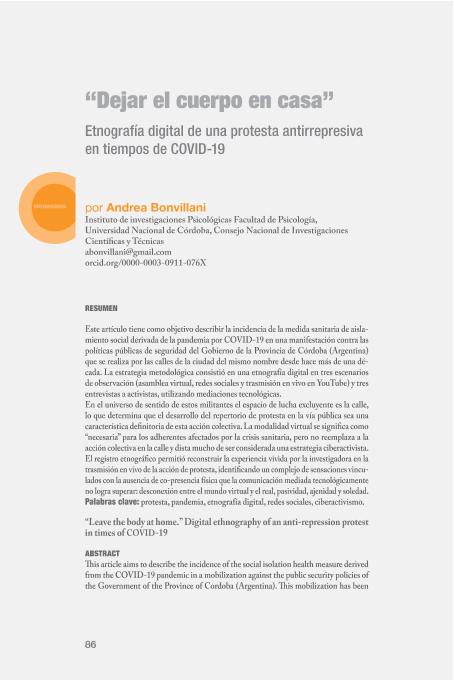Artículo
Este artículo tiene como objetivo describir la incidencia de la medida sanitaria de aislamiento social derivada de la pandemia por COVID-19 en una manifestación contra las políticas públicas de seguridad del Gobierno de la Provincia de Córdoba (Argentina) que se realiza por las calles de la ciudad del mismo nombre desde hace más de una década. La estrategia metodológica consistió en una etnografía digital en tres escenarios de observación (asamblea virtual, redes sociales y trasmisión en vivo en YouTube) y tres entrevistas a activistas, utilizando mediaciones tecnológicas. En el universo de sentido de estos militantes el espacio de lucha excluyente es la calle, lo que determina que el desarrollo del repertorio de protesta en la vía pública sea una característica definitoria de esta acción colectiva. La modalidad virtual se significa como “necesaria” para los adherentes afectados por la crisis sanitaria, pero no reemplaza a la acción colectiva en la calle y dista mucho de ser considerada una estrategia ciberactivista. El registro etnográfico permitió reconstruir la experiencia vivida por la investigadora en la trasmisión en vivo de la acción de protesta, identificando un complejo de sensaciones vinculados con la ausencia de co-presencia física que la comunicación mediada tecnológicamente no logra superar: desconexión entre el mundo virtual y el real, pasividad, ajenidad y soledad. This article aims to describe the incidence of the social isolation health measure derived from the COVID-19 pandemic in a mobilization against the public security policies of the Government of the Province of Cordoba (Argentina). This mobilization has been carried out through the streets of the city of the same name for more than a decade. The methodological strategy consisted of a digital ethnography based on three observation scenarios (virtual assembly, social networks and live broadcast on YouTube) and three interviews with activists, using technological media. In the universe of meaning of these activists, the excluding space of struggle is the street, thus protest on public roads is a defining characteristic of collective action. The virtual modality is defined as “necessary” for adherents affected by the health crisis, but it does not replace collective action in the street and is far from being considered a cyberactivist strategy. Ethnographic tools allowed me reconstruct the experience lived by the researcher in the live broadcast of the protest action, identifying a complex of sensations linked to the absence of physical co-presence that the technologically mediated communication cannot overcome: disconnection between the virtual world and the real, passivity, alienation and loneliness.
"Dejar el cuerpo en casa": Etnografía digital de una protesta antirrepresiva en tiempos de COVID-19
Título:
"Leave the body at home": Digital ethnography of an anti-repression protest in times of COVID-19
Fecha de publicación:
26/06/2023
Editorial:
Universidad Nacional de San Martín. Escuela Interdisciplinaria de Altos Estudios Sociales. Centro de Estudios en Antropología
Revista:
Etnografías Contemporáneas
ISSN:
2451-8050
Idioma:
Español
Tipo de recurso:
Artículo publicado
Clasificación temática:
Resumen
Palabras clave:
PROTESTA
,
PANDEMIA
,
ETNOGRAFIA DIGITAL
,
REDES SOCIALES
,
CIBERACTIVISMO
,
COVID-19
Archivos asociados
Licencia
Identificadores
Colecciones
Articulos (IIPSI)
Articulos de INSTITUTO DE INVESTIGACIONES PSICOLOGICAS
Articulos de INSTITUTO DE INVESTIGACIONES PSICOLOGICAS
Citación
Bonvillani, Andrea; "Dejar el cuerpo en casa": Etnografía digital de una protesta antirrepresiva en tiempos de COVID-19; Universidad Nacional de San Martín. Escuela Interdisciplinaria de Altos Estudios Sociales. Centro de Estudios en Antropología; Etnografías Contemporáneas; 9; 16; 26-6-2023; 86-110
Compartir




